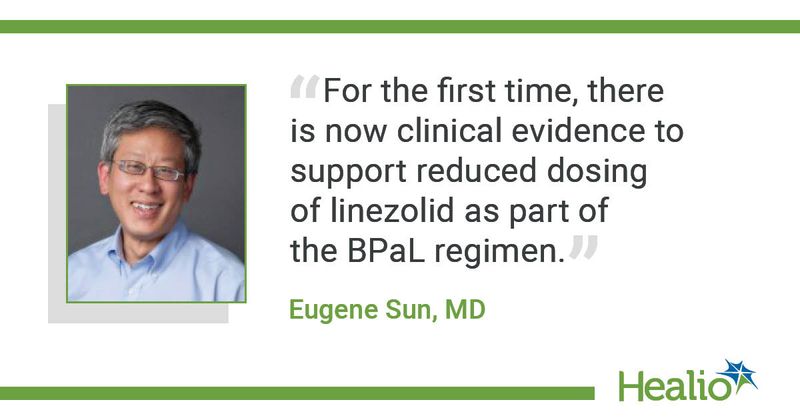Reduced dosing of linezolid in three-drug TB regimen lessens side effects
Click Here to Manage Email Alerts
Findings from the 6-month ZeNix trial indicated that a three-drug regimen for highly resistant tuberculosis was safer and just as effective when it included reduced doses or shorter durations of linezolid, researchers reported.
The regimen, known as BPaL, consists of bedaquiline, pretomanid and linezolid. It was developed by the TB Alliance as a 6-month, all-oral regimen to treat highly drug-resistant TB, said Eugene Sun, MD, senior vice president of research and development for the TB Alliance.

Sun noted that the regimen demonstrated a high cure rate in the Nix-TB Trial, leading the FDA to approve pretomanid as part of BPaL, but that linezolid has been associated with serious side effects when given at high doses for prolonged durations.
“This trial set out to examine whether those side effects could be reduced while still achieving high cure rates,” Sun told Healio.
The Nix-TB trial assessed a 6-month BPal regimen in which participants were started on 1,200 mg of linezolid daily. This resulted in an 89% durable cure rate at 24 months but also a high rate of linezolid-related adverse events, researchers reported at the IAS Conference on HIV Science.
In the ZeNix trial, the researchers enrolled patients with highly resistant TB in South Africa, Russia, Georgia and Moldova and treated them for 6 months with bedaquiline, pretomanid and varying doses and durations of linezolid, with follow-up to the primary endpoint 6 months after completion of treatment.
According to the study, the results of which were presented at the IAS meeting, the study’s 181 participants were treated for 6 months with bedaquiline (200 mg daily for 8 weeks followed by 100 mg daily for 18 weeks), pretomanid (200 mg daily) and were randomly assigned in an equal ratio to daily linezolid starting at 1,200 mg for 6 months (1,200L6M), 1,200 mg for 2 months (1,200L2M), 600 mg for 6 months (600L6M) or 600 mg for 2 months (600L2M).
The researchers evaluated participants at baseline, weekly for 8 weeks and then every 2 to 4 weeks through the end of treatment, monthly for 3 months, and at the primary endpoint 6 months after completion of treatment.
According to the researchers, the high success rate in each arm of the trial 93% in 1,200L6M, 89% in 1,200L2M, 91% in 600L6M and 84% in 600L2M was similar to the Nix-TB trial results, but patients in the 1,200L6M arm had higher rates of adverse events of peripheral neuropathy and myelosuppression (manifested as anemia): 38% and 22%, respectively, compared with 24% and 17% in the 1,200L2M arm, 24% and 2% in the 600L6M arm, and 13% and 7% in the 600L2M arm.
Additionally, four patients — all the 1,200L6M arm — had optic neuropathy that reversed, the researchers reported. More patients in the 1200L6M arm required linezolid dose modification either reduction, interruption or discontinuation than in any other arm (51% in 1,200L6M, 30% in 1,200L2M, 18% in 600L6M and 18% in 600L2M), they said.
“These results provide data that point to treatment options that may be associated with fewer side effects while still achieving high efficacy. The more we have effective and user-friendly treatments for TB, the more people can be successfully cured of their disease, which also reduces spread of disease and generation of drug-resistant TB,” Sun said. “For the first time, there is now clinical evidence to support reduced dosing of linezolid as part of the BPaL regimen.”

